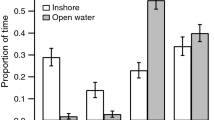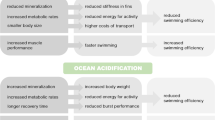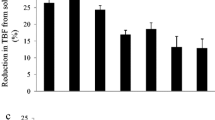Abstract
European round gobies (Neogobius melanostomus) are displacing several important native North American fish species. Controlling their invasion is contingent on understanding their swimming inclination and potential. We assessed goby swimming inclination by recording activity in a 2 m flume over a ~24 h period, and swimming potential using a critical swimming (U crit) test, as well as burst tests in still and flowing water. When given the choice to move, gobies covered as much as 14 m/h, with a slight bias towards nocturnal activity and an overall upstream preference. When confined and coerced to perform a U crit test, they burst-and-held to achieve 35.5 ± 1.1 cm/s. Thirty minutes following U crit, they were able to burst-and-coast in a sprint test to almost twice this speed. In still water, they exhibited startle bursts of up to 163 cm/s. We provide a swimming endurance model that indicates flow rates would need to be >125 cm/s to prevent upstream movement, and free of refuge areas in which to recover. The current study shows that the round goby is a surprisingly powerful swimmer with the capacity to continue its invasion should hydrologic control be absent.




Similar content being viewed by others
References
Almqvist G, Strandmark A, Appelberg M (2010) Has the invasive round goby caused new links in Baltic food webs? Environ Biol Fish 89:79–93
Alsop DH, Wood CM (1997) The interactive effects of feeding and exercise on oxygen consumption, swimming performance and protein usage in juvenile rainbow trout (Oncorhynchus mykiss). J Exp Biol 200:2337–2346
Beamish FWH (1978) Swimming capacity. In: Hoar WS, Randall DJ (eds) Fish physiology. Academic Press Inc, New York, pp 101–187
Blob RW, Wright KM, Becker M, Maie T, Iverson TJ, Julius ML, Schoenfuss HL (2007) Ontogenetic change in novel functions: waterfall climbing in adult Hawaiian gobiid fishes. J Zool 273:200–209
Bolliet V, Labonne J (2008) Individual patterns of rhythmic swimming activity in Anguilla anguilla glass eels synchronised to water current reversal. J Exp Mar Biol Ecol 362:125–130
Brett JR (1964) The respiratory metabolism and swimming performance of young sockeye salmon. J Fish Res Board Can 21:1183–1226
Brett JR (1972) The metabolic demand for oxygen in fish, particularly salmonids, and a comparison with other vertebrates. Resp Physiol 14:151–170
Bronnenhuber JE, Dufour BA, Higgs DM, Heath DD (2011) Dispersal strategies, secondary range expansion and invasion genetics of the nonindigenous round goby, Neogobius melanostomus, in Great Lakes tributaries. Mol Ecol. doi:10.1111/j.1365-294X.2011.05030.x
Castro-Santos T (2005) Optimal swim speeds for traversing velocity barriers: an analysis of volitional high–speed swimming behavior of migratory fishes. J Exp Biol 208:421–432
Chotkowski MA, Marsden JE (1999) Round goby and mottled sculpin predation on lake trout eggs and fry: Field predictions from laboratory experiments. J Great Lakes Res 25:26–35
Deitch EJ, Fletcher GL, Petersen LH, Costa IASF, Shears MA, Driedzic WR, Gamperl AK (2006) Cardiorespiratory modifications, and limitations, in post-smolt growth hormone transgenic Atlantic salmon Salmo salar. J Exp Biol 209:1310–1325
del Norte-Campos AGC, Temming A (1994) Daily activity, feeding and rations in gobies and brown shrimp in the northern Wadden Sea. Mar Ecol-Prog Ser 115:41–53
Ehrenberg S, Ejdung G (2008) Daily activity pattern of the sand goby, Pomatoschistus minutus (Pisces), at low light intensity. Hydrobiologia 603:129–137
Farrell AP (2008) Comparisons of swimming performance in rainbow trout using constant acceleration and critical swimming speed tests. J Fish Biol 72:693–710
Farrell AP, Lee CG, Tierney K, Hodaly A, Clutterham S, Healey M, Hinch S, Lotto A (2003) Field-based measurements of oxygen uptake and swimming performance with adult Pacific salmon using a mobile respirometer swim tunnel. J Fish Biol 62:64–84
Hammer C, Temming A, Schubert H-J (1994) Diurnal variations in swimming activity of Rutilus rutilus (Cyprinidae) in a group under tank conditions. Int Rev Gesamten Hydrobiol Hydrograph 79:385–396
Hensler SR, Jude DJ (2007) Diel vertical migration of round goby larvae in the great lakes. J Great Lakes Res 33:295–302
Hoover JJ, Adams SR, Killgore KJ (2003) Can hydraulic barriers stop the spread of the round goby? TN ANSRP-03-1, U.S. Army Corps of Engineers, US Army Engineer Research and Development Center (ERDC), Vicksburg, MS
Jobling M, Davies PS (1980) Effects of feeding on metabolic rate, and the specific dynamic action in plaice, Pleuronectes platessa L. J Fish Biol 16:629–638
Jude DJ, Reider RH, Smith GR (1992) Establishment of Gobiidae in the Great-Lakes Basin. Can J Fish Aquat Sci 49:416–421
Kanter MJ, Coombs S (2003) Rheotaxis and prey detection in uniform currents by Lake Michigan mottled sculpin (Cottus bairdi). J Exp Biol 206:59–70
Kornis MS, Vander Zanden MJ (2010) Forecasting the distribution of the invasive round goby (Neogobius melanostomus) in Wisconsin tributaries to Lake Michigan. Can J Fish Aquat Sci 67:553–562
Krakowiak PJ, Pennuto CM (2008) Fish and macroinvertebrate communities in tributary streams of eastern Lake Erie with and without round gobies (Neogobius melanostomus, Pallas 1814). J Great Lakes Res 34:675–689
Lauer TE, Allen PJ, McComish TS (2004) Changes in mottled sculpin and johnny darter trawl catches after the appearance of round gobies in the Indiana waters of Lake Michigan. Trans Am Fish Soc 133:185–189
Lee CG, Farrell AP, Lotto A, MacNutt MJ, Hinch SG, Healey MC (2003) The effect of temperature on swimming performance and oxygen consumption in adult sockeye (Oncorhynchus nerka) and coho (O. kisutch) salmon stocks. J Exp Biol 206:3239–3251
Lefrançois C, Claireaux G (2003) Influence of ambient oxygenation and temperature on metabolic scope and scope for heart rate in the common sole Solea solea. Mar Ecol Prog Ser 259:273–284
Martinez M, Bedard M, Dutil J-D, Guderley H (2004) Does condition of Atlantic cod (Gadus morhua) have a greater impact upon swimming performance at Ucrit or sprint speeds? J Exp Biol 207:2979–2990
Mills EL, Leach JH, Carlton JT, Secor CL (1993) Exotic species in the great lakes - A history of biotic crises and anthropogenic introductions. J Great Lakes Res 19:1–54
Montgomery J, Coombs S, Halstead M (1995) Biology of the mechanosensory lateral line in fishes. Rev Fish Biol Fish 5:399–416
Nelson JA, Claireaux G (2005) Sprint swimming performance of juvenile European sea bass. Trans Am Fish Soc 134:1274–1284
Nelson JA, Gotwalt PS, Reidy SP, Webber DM (2002) Beyond Ucrit: matching swimming performance tests to the physiological ecology of the animal, including a new fish ‘drag strip’. Comp Biochem Physiol 133A:289–302
Peake SJ (2008) Behavior and passage performance of northern pike, walleyes, and white suckers in an experimental raceway. North Am J Fish Manage 28:321–327
Peake S, McKinley RS (1998) A re-evaluation of swimming performance in juvenile salmonids relative to downstream migration. Can J Fish Aquat Sci 55:682–687
Petersen LH, Gamperl AK (2010) Effect of acute and chronic hypoxia on the swimming performance, metabolic capacity and cardiac function of Atlantic cod (Gadus morhua). J Exp Biol 213:808–819
Petersen JK, Petersen GI (1990) Tolerance, behaviour and oxygen consumption in the sand goby, Pomatoschistus minutus (Pallas), exposed to hypoxia. J Fish Biol 37:921–933
Poos M, Dextrase A, Schwalb A, Ackerman J (2010) Secondary invasion of the round goby into high diversity Great Lakes tributaries and species at risk hotspots: potential new concerns for endangered freshwater species. Biol Invasions 12:1269–1284
Rahel FJ (2007) Biogeographic barriers, connectivity and homogenization of freshwater faunas: it's a small world after all. Freshwater Biol 52:696–710
Reidy SP, Kerr SR, Nelson JA (2000) Aerobic and anaerobic swimming performance of individual atlantic cod. J Exp Biol 203:347–357
Steinhart GB, Marschall EA, Stein RA (2004) Round goby predation on smallmouth bass offspring in nests during simulated catch-and-release angling. Trans Am Fish Soc 133:121–131
Tierney KB, Farrell AP (2004) The relationships between fish health, metabolic rate, swimming performance and recovery in return-run sockeye salmon, Oncorhynchus nerka (Walbaum). J Fish Dis 27:663–671
Tierney KB, Paterson DA, Kennedy CJ (2009) The influence of maternal condition on offspring performance in sockeye salmon (Oncorhynchus nerka Walbaum). J Fish Biol 75:1244–1257
Tudorache C, Viaenen P, Blust R, de Boeck G (2007) Longer flumes increase critical swimming speeds by increasing burst-glide swimming duration in carp Cyprinus carpio, L. J Fish Biol 71:1630–1638
Acknowledgment
The authors greatly appreciated the talent and hard work of Marc St. Pierre and Steve Budinski of the University of Windsor’s Science Technical Shop in constructing the complicated swim tunnel respirometer used in this study. The authors thank Christine Cobbler for help with swim tunnel calibrations and Bianca Mancini for help with goby burst swimming measurements. We thank Jan Ciborowski and Lynda Corkum (Windsor) for use of their flow probe, and Doug Wiens (Alberta) for help with statistics. Funding was provided by NSERC grants to KBT, BSZ and DMH, and by the Ontario Ministry of Natural Resources to DMH.
Author information
Authors and Affiliations
Corresponding author
Rights and permissions
About this article
Cite this article
Tierney, K.B., Kasurak, A.V., Zielinski, B.S. et al. Swimming performance and invasion potential of the round goby. Environ Biol Fish 92, 491–502 (2011). https://doi.org/10.1007/s10641-011-9867-2
Received:
Accepted:
Published:
Issue Date:
DOI: https://doi.org/10.1007/s10641-011-9867-2




